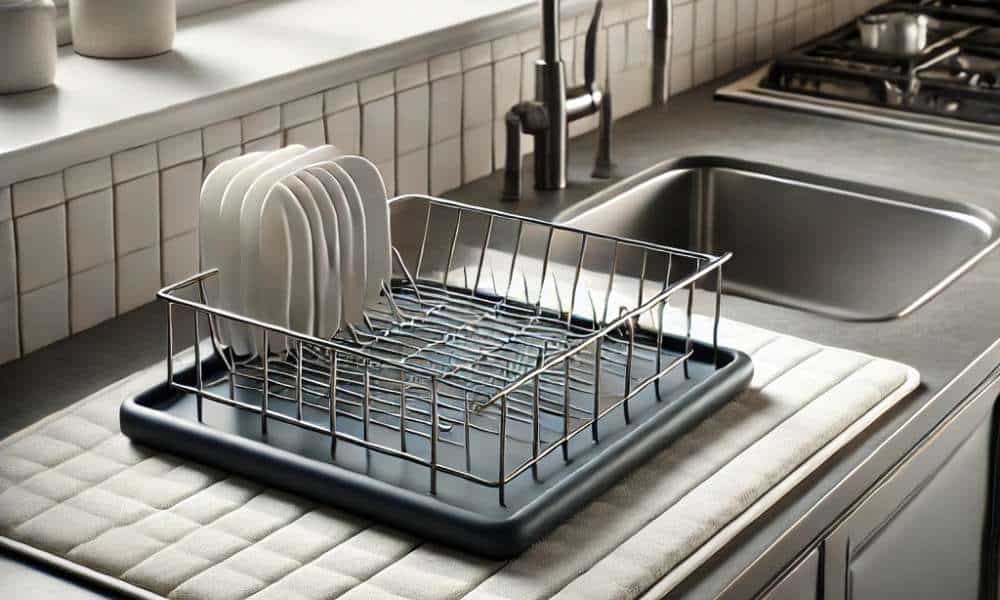A dish drying rack is a kitchen essential, but without the right protection underneath, it can lead to water puddles, stains, and even mold growth. Choosing what to put under dish drying rack is key to keeping your countertop dry, clean, and damage-free. From absorbent mats to trays with drainage systems, there are plenty of options to fit your needs. In this guide, we’ll explore the best materials to use, their pros and cons, and how to maintain a mess-free kitchen. Let’s find the perfect solution to keep your counters spotless!
1. Why You Need Protection Under Your Dish Drying Rack
Protective materials under dish drying racks are essential for several reasons. They prevent water damage that can cause unsightly stains and structural harm to sensitive materials like wood and granite. Beyond physical damage, stagnant water is a breeding ground for bacteria and mold, posing health risks and creating unpleasant odors. Effective water management under your rack simplifies maintenance, making it easier to keep your kitchen in pristine condition. By understanding the different countertop materials and their vulnerabilities to water, you can choose the most effective protective solution.
2. Best Materials to Put Under a Dish Drying Rack
The choice of material for under your dish drying rack should balance functionality with aesthetics:
- Microfiber Dish Mats: These are ideal for their super absorbency and ease of maintenance. They dry quickly and can be machine washed, making them a convenient option for busy kitchens.
- Silicone Dish Mats: Known for their durability and water resistance, silicone mats are also non-slip, which ensures that dishes and the rack itself remain stable. Their heat-resistant properties also allow them to double as trivets.
- Rubber Mats: If you’re looking for a heavy-duty option, rubber mats are perfect due to their robustness and waterproof nature. They’re easy to clean and provide excellent grip for the dish rack.
- Dish Drying Trays with Drainage: These are engineered to channel excess water directly into the sink, thereby keeping countertops dry without the constant need for towel drying. They are particularly useful in kitchens where the dish rack is not over a sink.
- Bamboo or Wooden Boards: Offering a warm, natural aesthetic, these boards need to be treated for water resistance but can significantly elevate the look of your kitchen.
- DIY & Recycled Solutions: For a budget-friendly approach, consider using old towels cut to size or repurposed waterproof tablecloths. These materials can be easily washed and replaced, offering a flexible solution to under-rack moisture.
3. Choosing the Right Solution Based on Countertop Material
Different countertop materials react uniquely to moisture, making it essential to choose the right protective layer. Granite and marble are porous and prone to water stains, so silicone mats or draining trays that channel excess water into the sink are ideal. Wooden countertops absorb moisture, leading to warping, so microfiber mats or treated bamboo boards offer better protection. Laminate surfaces can swell with prolonged exposure to water, making rubber or silicone mats preferable. Stainless steel is durable but benefits from drying trays to maintain organization and cleanliness.
4. Installation & Placement Tips
Proper placement of under-rack materials ensures maximum efficiency and countertop protection. Position the dish rack and protective layer near the sink for optimal drainage. If using a drying tray, angle it slightly so excess water flows directly into the sink. Non-slip mats or adhesive grips prevent shifting and slipping, keeping everything securely in place. When using a microfiber mat or towel, replace it frequently to prevent bacterial growth. Always ensure the protective material covers the entire area beneath the dish rack for comprehensive moisture control.
5. Cleaning and Maintenance of Under-Rack Materials
Regular cleaning of under-rack materials prevents bacterial buildup and extends their lifespan. Microfiber mats should be washed weekly to remove dirt and odors. Silicone and rubber mats can be rinsed daily and deep-cleaned with mild detergent weekly. Drying trays require frequent wiping to prevent stagnant water and mildew formation. Wooden boards should be sealed periodically and wiped dry after each use. Avoid prolonged exposure to moisture by ensuring all protective materials are fully dry before repositioning them under the dish rack.
6. Common Mistakes to Avoid
Many homeowners unknowingly compromise their kitchen hygiene by making simple mistakes. One major error is using absorbent materials like towels without frequent washing, leading to mold growth. Letting water pool under the rack causes permanent countertop damage, particularly on wood and laminate surfaces. Choosing the wrong protective material—such as placing untreated wood under the rack—can accelerate deterioration. Ignoring regular cleaning of mats and trays results in bacterial buildup. To maintain a hygienic and functional kitchen, always use water-resistant, easy-to-clean materials and establish a consistent maintenance routine.
Conclusion
Implementing the right moisture management solutions under your dish drying rack can significantly enhance the cleanliness, functionality, and appearance of your kitchen. This guide has outlined various materials and methods to help you choose the best option for your needs, ensuring that your countertops remain dry, hygienic, and visually appealing.

